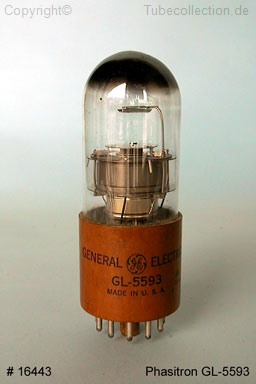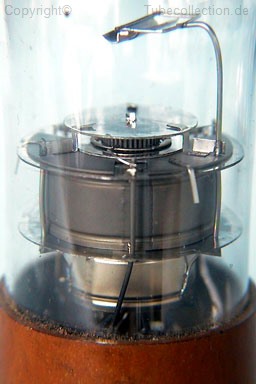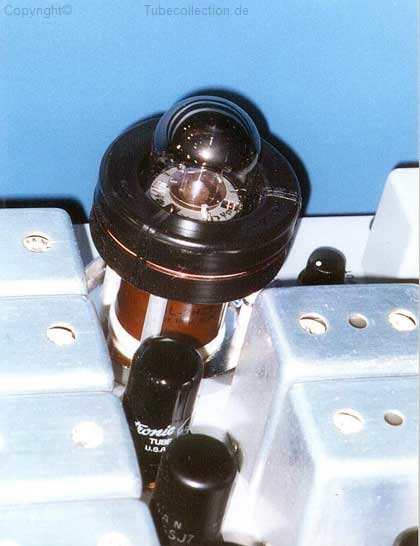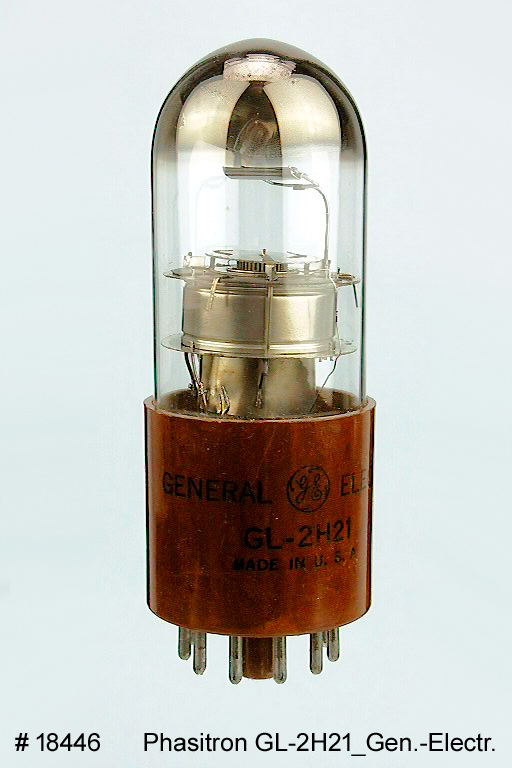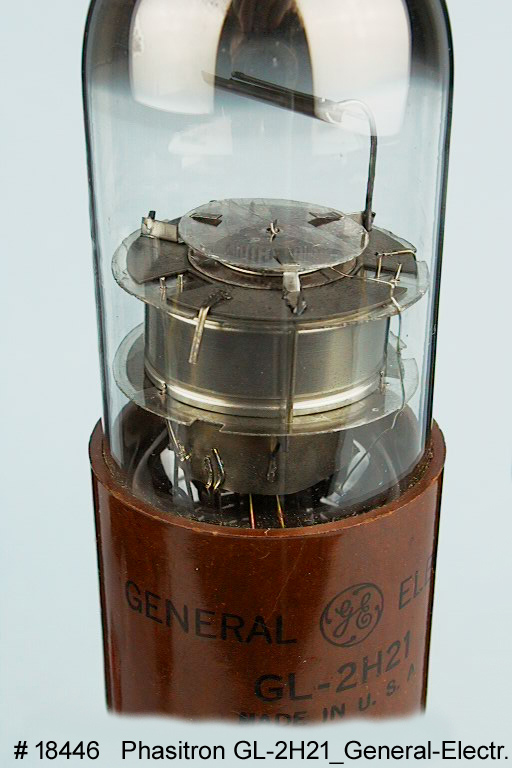|
Allgemein Phasitrons sind eine Erfindung der General Electric in den 50er Jahren. Mit den Röhren wurde in FM-Sendern die Modulation durchgeführt. Das Hauptproblem bestand damals in der Konstanthaltung der Frequenz, die durch geeignete Maßnahmen ständig korrigiert werden musste. Mit dem Phasitron konnte nun erstmals die Frequenz mittels Quarz-Kristall erzeugt und konstant gehalten werden. Die Modulation erfolgte mittels der Phasitron-Röhre, die in einer Audio-Spule steckte, deren magnetisches Feld den Elektronenfluss in der Röhre beeinflusste und so die Phase steuerte. Funktion Im Phasitron werden Elektronen erzeugt und zu einer dünnen Scheibe fokussiert. Sie fließen radial zu einem Paar konzentrische angeordneter Anoden.Der innere Anodenring hat eine Vielzahl Öffnungen, der äußere Ring ist geschlossen. Somit trifft von den Elektronen ein Teil auf die innere Anode, ein anderer Teil durch die Löcher hindurch auf die äußere Anode. Die Schlitze in den inneren Anode wurden auch gestaffelt, so dass in einem Augenblick, der Großteil der Elektronen durch die Schlitze an die äußeren Anode gelangen würde. 180 Grad später, gelangen die Elektronen nur auf die innere Anode. Das Ausgangs-Signal wird also beiden Anoden entnommen. Wird also eine Spule über die Röhre gesteckt und diese mit der Spannung des Audioverstärkers betrieben, so wechselt das Magnetfeld im Rhythmus der Audiofrequenz und bewirkt eine Phasenmodulation. Das bedeutete, dass die "Phase-Modulation" aus der
Röhre war eigentlich Frequenzmodulation. Die Spule, in
der Tat, war die Umwandlung von PM in FM. Von den Phasitrons gab es 2 Typen, GL-2H21 und GL-5593. Sehr ausführliche Beschreibungen der Technologie ist in englischer
Sprache zu finden
unter: Daten und Detailfotos siehe auch: |
General The inventor of the "Phasitron" was General Electric in the 50th. The tube was used to manage phase and frequency modulation. The major problem at that time was to keep the oscillator frequency constant. Specific actions were neccessary. By using the "Phasitron" the frequency could be cristal generated and kept stabile. The modulation was managed by putting an audio driven coil over the tube whose magnetic field was affecting the electron movement inside the tube.
Function The Phasitron produced a thin, focused disk of electrons, flowing radially to a pair of concentric cylindrical anodes. One anode had slots punched in it so that some of the electrons would hit the inner anode, and others would go through the slots and hit the second anode. Then, using a three phase excitation on three sets of radial grid wires, "ruffles" were formed on the electron disk. (Around the periphery of the electron disk, the edge was bent up and down.) The three phases were set up so that the "ruffles" would rotate. The slots in the inner anode were also staggered so that at one instant, most of the electrons would be going through the slots to the outer anode. 180 degrees later, the electrons would miss the slots and hit the inner anode. So, the output from the tube was taken differentially from the two anodes. Now comes the interesting part. Apply a magnetic field axially to the tube, and the electron disk (and its "ruffles") will twist clockwise. Apply the field the other way, and the electron disk will twist counterclockwise. This produces phase modulation - a lot of it. So, the Phasitron tube was mounted in a coil that had the station's pre-emphasized audio applied to it. With an audio voltage applied to the coil, the magnetic field was the integral of the applied voltage. So, the phase modulation was also the integral of the applied voltage. That meant that the "phase modulation" coming out of the tube was actually FREQUENCY modulation. The coil, in effect, was converting PM to FM by virtue of its 6 dB per octave slope! So, the whole system was downright clever. A tube that produced FM, yet with crystal controlled accuracy! 2 types of "Phasitrons" are known, the GE-2H21 and the GL5593.
A very detailed description about the technology is published at: http://www.w9gr.com/phasitron.html More details and datas about the tube see also : |
